Frankly, Cranky Owlet…
…finds songbirds a nuisance.
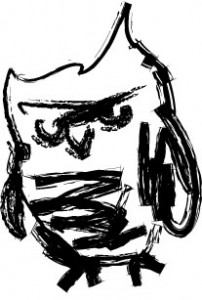
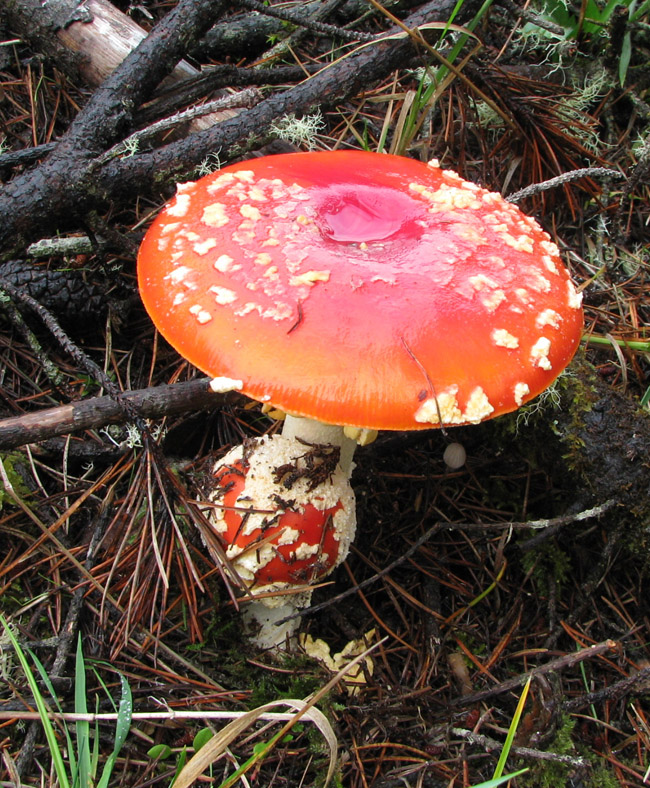 It’s not very much like the Sonoran Desert here. Everything’s either wet or damp, and when it rains it’s not a pounding monsoonal deluge that ends quickly, but a steady long-term soaking, which might last hours, days, or the rest of the year. Things that live here are water-loving organisms, like Loons and Mushrooms.
It’s not very much like the Sonoran Desert here. Everything’s either wet or damp, and when it rains it’s not a pounding monsoonal deluge that ends quickly, but a steady long-term soaking, which might last hours, days, or the rest of the year. Things that live here are water-loving organisms, like Loons and Mushrooms.
E got great photos of some of the numerous – and poisonous – Fly agaric mushrooms (Amanita muscaria) pushing up through the evergreen needles on Clatsop Spit. There were other varieties of fungus in abundance too, little brown guys with caps so transluscent their gills showed through, and big slick yellow ones with a slime sheen on top. As well as fungi, the moist forests had sprouted mushroom hunters galore: some with five gallon plastic buckets topped with edible varieties, perhaps chanterelles.
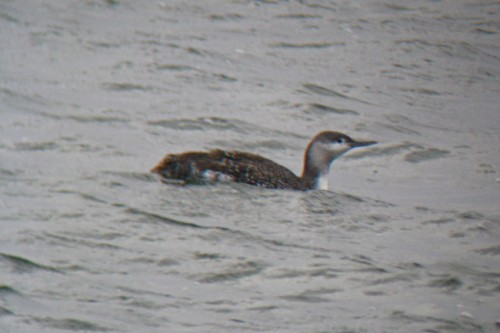 Less colorful but still nice to see were an assortment of loons: Common, still sporting a bit of their black-and white summer plumage; a juvenile Pacific loon with its silvery neck; and a pair of Red-throated loons close to shore (left), with their distinctive pale tip-tilted bills, and backs whose pattern looks like the texture on a manhole cover.
Less colorful but still nice to see were an assortment of loons: Common, still sporting a bit of their black-and white summer plumage; a juvenile Pacific loon with its silvery neck; and a pair of Red-throated loons close to shore (left), with their distinctive pale tip-tilted bills, and backs whose pattern looks like the texture on a manhole cover.
Fortunately, sea birds and waders are out in all weather, so even on the wind-whipped estuaries and rain-lashed beaches, there are things to see, like this distant dotted line of Brown pelicans speeding 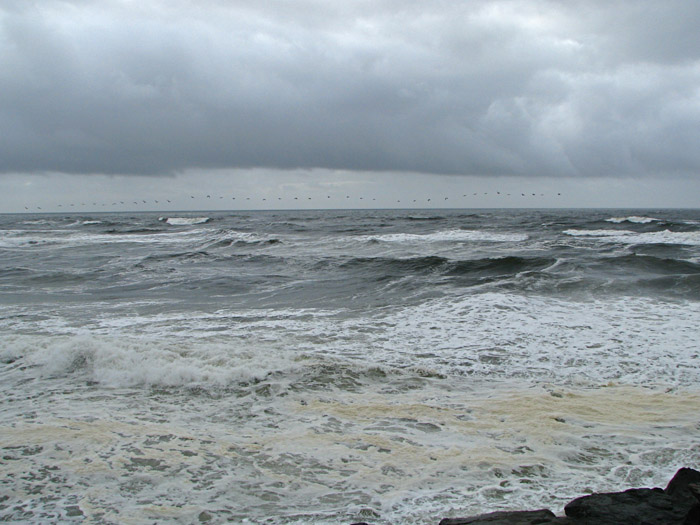 down-wind on a gale at the South Jetty at Fort Stevens State Park.
down-wind on a gale at the South Jetty at Fort Stevens State Park.
(Top photo: Fly agaric mushroom, E.Shock; middle: Red-throated loon, only adequately digiscoped by A.Shock; stormy Pacific coast with brown pelicans, A.Shock)
 Allison does not consider herself a wildlife artist,
but an observer who takes notes in clay.
More info...
Allison does not consider herself a wildlife artist,
but an observer who takes notes in clay.
More info...

Recently a neighbor came across the street to tell me in a concerned way that she had “had to” kill not just one but two non-venomous coachwhips in her yard out of fear for the safety of her pet, a feisty little terrier whom no self-respecting coachwhip would allow near enough for trouble. So it was very good to discover that “our” coachwhips on this side of the street, whom we see with some frequency, had managed to reproduce, to help offset the unnecessary slaughter.
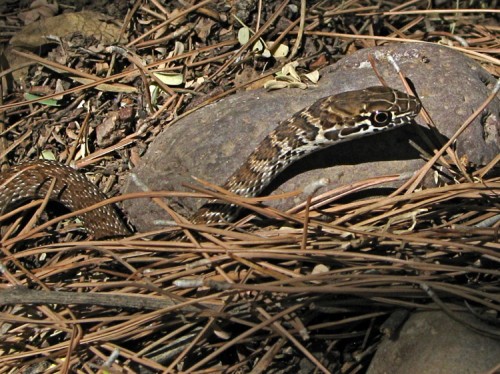 This handsome youngster and I surprised each other under the hummingbird feeder in the palo verde, and it held still enough for long enough that we were able to get some photos. I suspect it was after young Tiger whiptails, among other things, as they’re still out and about (the larger adults seem already to have retreated to their subterranean refuges for the season, for the most part). In fact, nearby on the same day, quite a young whiptail was chasing small ants with gusto. It no longer sported its blue tail, but had the slim body and large-headedness of a young reptile.
This handsome youngster and I surprised each other under the hummingbird feeder in the palo verde, and it held still enough for long enough that we were able to get some photos. I suspect it was after young Tiger whiptails, among other things, as they’re still out and about (the larger adults seem already to have retreated to their subterranean refuges for the season, for the most part). In fact, nearby on the same day, quite a young whiptail was chasing small ants with gusto. It no longer sported its blue tail, but had the slim body and large-headedness of a young reptile.
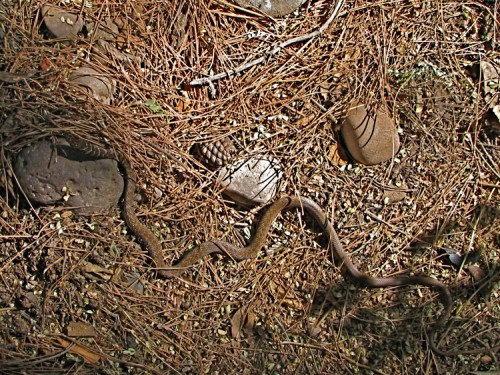 Coachwhips (Masticophis flagellum) lay their eggs in June and July, and the young begin to maraud in August and September. So this well-camouflaged youth is probably a month or two old, and already a whippy thin 13 or 14 inches in length.
Coachwhips (Masticophis flagellum) lay their eggs in June and July, and the young begin to maraud in August and September. So this well-camouflaged youth is probably a month or two old, and already a whippy thin 13 or 14 inches in length.
“When frightened it flees so rapidly it appears to magically disappear into the desert,” say Brennan and Holycross in their excellent 2006 Field Guide to Amphibians and Reptiles of Arizona. And that’s exactly how this encounter ended, when the little snakelet finally decided it was time to vamoose.
(Photos: Top: A.Shock; bottom, E.Shock)
…and we spent the day near Sedona in the Red Rocks and Wet Beaver Creek visiting Palatki and V-V (a ranch brand pronounced Vee-Bar-Vee), both quite spectacular rock art venues.
These are fairly easily accessible sites maintained by the Forest Service for public viewing, and well worth the trip (around 2 1/2 hours from Phoenix, much less from Flagstaff), if indigenous works of art are your thing. Palatki is primarily pictographs — images applied to the rock faces with mixtures of charcoal or mineral pigments and natural binders like animal fat. There’s also a well-preserved “cliff dwelling” perched comfortably in the delightfully red Supai Sandstone formation. V-V is primarily petroglyphs, figures pecked or incised into the sandstone with hard tools. Both sites feature an abundance of animal images, anthropomorphic figures including ones
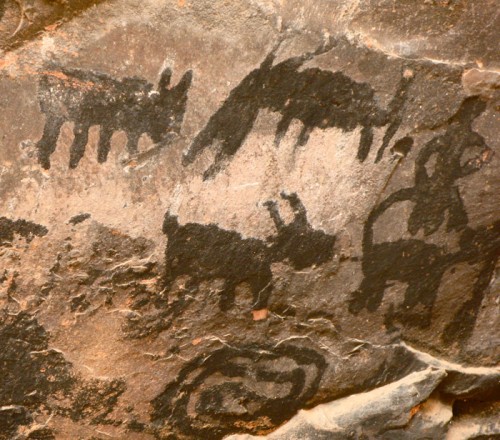 referred to as “shamanic”, plus geometric and astronomical symbols. These two locations have been used successively by a variety of inhabitants, from the Archaic people to Sinagua, Hohokam, Yavapai, Apache, and early Anglo and Hispanic homesteaders: in places the images are many layers thick, representing thousands of years of expression.
referred to as “shamanic”, plus geometric and astronomical symbols. These two locations have been used successively by a variety of inhabitants, from the Archaic people to Sinagua, Hohokam, Yavapai, Apache, and early Anglo and Hispanic homesteaders: in places the images are many layers thick, representing thousands of years of expression.
Interpretation of parietal art seems largely subjective, and despite folksy presentations by earnest volunteers nothing we were presented with was entirely convincing, so I won’t inflict anyone with any of it here. But the art is impressive, both in technique and aesthetics, so I’ll satisfy myself with admiration, and leave others to struggle with meaning.
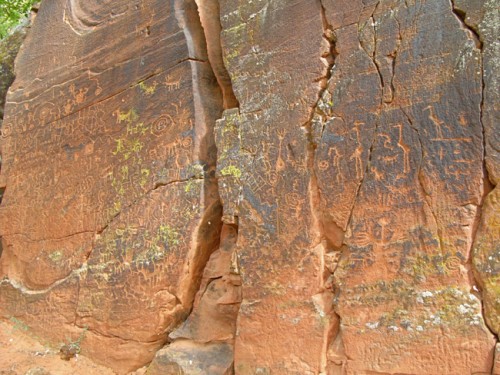 It’s a fascinating struggle, and teeters a little antagonistically between local experts, eddycated archeologists, and Native American Interpreters, all of whom seem to have strong opinions and, often, little tolerance for each other’s views. Oddly, more than once we heard a little bashing of the two extremes of scholarly and indigenous input, with the hero being the guy who wasn’t an expert — who didn’t have the “in” of either academia or ancestry — figuring it all out. This left the impression of a tale arising from the Mystery of the Lost Symbols that seems just as rooted in folkloric tradition as the images themselves.
It’s a fascinating struggle, and teeters a little antagonistically between local experts, eddycated archeologists, and Native American Interpreters, all of whom seem to have strong opinions and, often, little tolerance for each other’s views. Oddly, more than once we heard a little bashing of the two extremes of scholarly and indigenous input, with the hero being the guy who wasn’t an expert — who didn’t have the “in” of either academia or ancestry — figuring it all out. This left the impression of a tale arising from the Mystery of the Lost Symbols that seems just as rooted in folkloric tradition as the images themselves.
If you’d like to visit these sites, and nearby Honanki, be sure to check out the links above for details, since advanced reservations are necessary for Palatki, and hours are quite limited for V-V.
(Photos: Top, Palatki, “Red House” ruins, A.Shock; middle: black herd, Palatki, A.Shock; bottom: overview of one of the V-V petroglyph panels, possibly a calendar overlaid with clan symbols)
The other morning around 6 am I was awakened by a neighbor: the Army National Guard’s Papago Military Station thumped deafeningly with the rotors of helicopters. I went out to look: the National Guard is usually a quiet neighbor, with only occasional popping of target practice audible from our street. The airstrip no longer hosts fixed-wing craft, so apart from infrequent “chopper” traffic, we’re not often disturbed by activities on the Reservation.
But this morning, the din was hard to ignore so I went out front to watch. The houses across the street are slightly up hill from ours, so my view was over their rooves, and at first I couldn’t see anything but a rolling cloud of brown dust like a haboob, kicked up as the ‘copters waited on the old landing strip.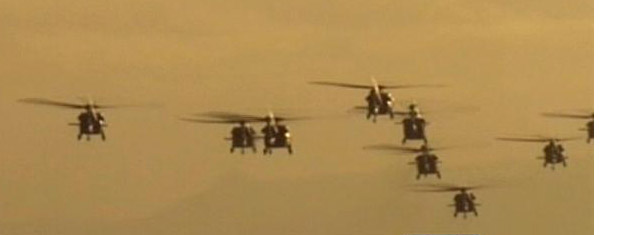
For more than three quarters of an hour, the rotors thumped. From the enormous noise they were making, I guessed there was more than one, maybe three or four. At 7 am, they lifted off — TEN Blackhawk helicopters, one at a time, to the east, headed to Fort Sill Oklahoma to join the 2-285th Aviation Assault Battalion, eventually bound for Iraq. Ten! — no wonder the sound of their blades shook the ground, throbbed in my ribs.
Whatever your feelings about Instruments of War, ten powerful Blackhawk helicopters heavily rising one by one into the dawnzerly light make an impressive scene, the roar of the blades changing with the stress of becoming airborne. There was something surreal about it, somehow outside Nature, when measured by my usual yardstick of even the largest flying creatures we’re accustomed to in the desert neighborhood: Common ravens, Great horned owls, and Turkey vultures. These giant copters were like winged prehistoric creatures that ought to be too massive to fly: Pterodactyls are our neighbors.
Scorpions are not a thing at our house. We don’t see them frequently, and as previously posted, they’re more likely to be encountered outside as victims of the swimming pool than inside the house. But last night E liberated one from the front bathroom, and temporarily incarcerated it in a pint glass.
In the morning, I wanted to watch it glow. Here’s a picture of it viewed under a UV light, with the glass’s Duralex logo for scale. It’s another “striper”: Vaejovis spinigera, a stripe-tailed scorpion, our most common species.
There are places in the Greater Phoenix famous for their scorpionicity. So much so, that you can find maps of the frequency of scorpion stings on the internet, for the benefit of people new to the area who might want the info while searching for a house to buy. (We looked at a map of Superfund sites, but everyone has to prioritize their own worries). Such a map is to the right: the darkest areas show the areas with the most stings reported, so it’s more likely to reflect factors such as human population density or likeliness of going to the hospital than actual scorpion presence. Also, the map doesn’t indicate actual numbers or a unit of time, so there’s no knowing if the darkest red are so many stings a year, or so many stings a minute. But, it provides a rough idea of who should invest in a hand-held black-light, and who’s most likely to subscribe to weekly pest control.
(We looked at a map of Superfund sites, but everyone has to prioritize their own worries). Such a map is to the right: the darkest areas show the areas with the most stings reported, so it’s more likely to reflect factors such as human population density or likeliness of going to the hospital than actual scorpion presence. Also, the map doesn’t indicate actual numbers or a unit of time, so there’s no knowing if the darkest red are so many stings a year, or so many stings a minute. But, it provides a rough idea of who should invest in a hand-held black-light, and who’s most likely to subscribe to weekly pest control.
Oddly, the scorpion-rich areas are not all desert neighborhoods as you might expect: there’s a hot spot in Tempe with lawns and sprinklers and rose-bushes, and another in the central corridor of older Phoenix. We’ve got friends who live there, and they see scorps way more often than we do, and have been stung. As a kid in Phoenix, I remember being afraid of scorpions after hearing stories of people leaving wet washcloths on the bathroom floor, and finding several of them clinging to the underside of it when it was picked up next morning. (Scorpions love getting under things and hanging there upside down. Biologists call this “reverse geotaxis”: the habit of aligning yourself in reverse to the surface of the earth.) Fortunately, in our area, for most people the sting of most scorpions is a painful inconvenience, and nothing more. There are places in the world where there are much more potent scorps, and their sting is a medical matter and is even occasionally fatal.
After its photo-session, I released this striper in the back yard, under a Cenizo bush, where it clung to some foliage. By the time the sun strikes the plant, it’ll be back in a hidey-hole until night falls again.
(Photo A.Shock; scorpion wrangling E.Shock)
The answer is all of the above. Long a mainstay of Three Star Owl sculptural subjects, this pointy-ended, feisty-looking, toothy mammal has been called all of them. And that would be correct — called a “rαtdog” 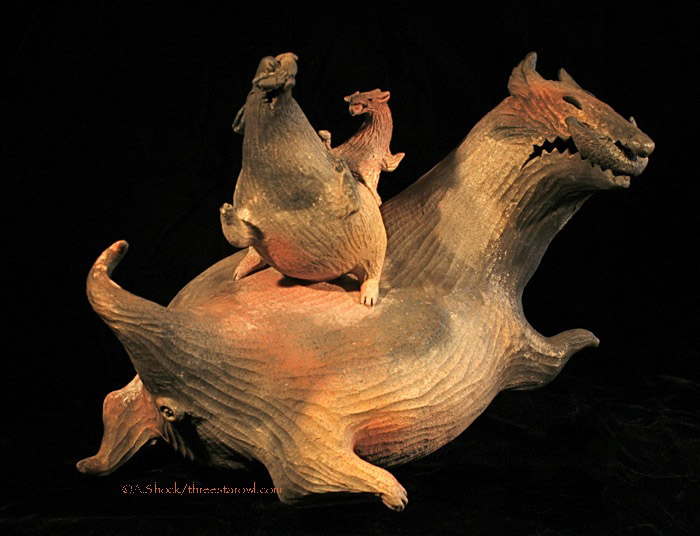 for convenience — it stands for Every Mammal, including us human ones. Rαtdogs represent the Mammalian experience, and are intended to repulse and appeal simultaneously. My hope is that people will want to pick one up, even though it looks like it might bite, or transmit a disease.
for convenience — it stands for Every Mammal, including us human ones. Rαtdogs represent the Mammalian experience, and are intended to repulse and appeal simultaneously. My hope is that people will want to pick one up, even though it looks like it might bite, or transmit a disease.
Above is the latest rαtdog piece, “FishDog Stack”, fresh from its smoky firing. Like the related piece Toadstack, it’s mainly about heterotrophy: eating other organisms, but only because rαtdogs haven’t figured out how to synthesize cholorophyll yet. FishDog Stack just trundled off to its new home this afternoon, which always makes me happy.
(Photo A.Shock. Currently there’s a detail of FishDog Stack on my Homepage. Also check out an image of an earlier rαtdog piece “Acorn Competition” in the Gallery — click on the third thumbnail at the bottom.)
Late afternoon light makes this Flamingo at the Phoenix Zoo fiery pink. (Photo E.Shock)
The weather has cooled a bit, and even the succulents in the yard are perking up a little. Here’s a shot of a luncheon-plate sized flower of a nocturnal, non-native Cereus aethiops columnar cactus, taken at dawn before it faded in the rays of the sun.
(Photo of Cereus aethiops blossom by A.Shock)